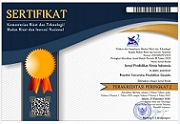PENGARUH PENGGUNAAN SCHOOLOGY DALAM MODEL BELAJAR LEARNING CYCLE 6 FASE-PROBLEM SOLVING (LC 6F-PS) TERHADAP PEMAHAMAN KONSEPTUAL DAN GRAFIK PADA MATERI LAJU REAKSI
DOI:
https://doi.org/10.23887/jpk.v3i2.20982Abstrak
ABSTRAK
Tujuan penelitian ini adalah (1) untuk mengetahui pengaruh penggunaan schoology dalam model belajar learning cycle 6F-problem solving terhadap pemahaman konseptual dan grafik siswa pada materi laju reaksi dan (2) mengetahui apakah ada hubungan antara pemahaman monseptual dengan pemahaman grafik siswa pada materi laju reaksi. Penelitian ini menggunakan rancangan penelitian eksperimental semu postest only design. Populasi penelitian adalah siswa kelas XI MIPA SMA Negeri 1 Genteng. Sampel yang digunakan yaitu kelas XI MIPA 4 sebagai kelas eksperimen dan XI MIPA 5 sebagai kelas kontrol. Pengujian hipotesis dianalisis menggunakan uji t dan uji korelasi dengan taraf signifikansi . Hasil penelitian menunjukkan (1) ada perbedaan yang signifikan tingkat pemahaman konseptual dan grafik siswa yang dibelajarkan dengan menggunakan aplikasi schoology dalam model belajar learning cycle 6F-problem solving dengan siswa yang dibelajarkan menggunakan model belajar learning cycle 6F-problem solving dan (2) tidak ada hubungan signifikan ntara tingkat pemahaman konseptual dengan pemahaman algoritmik siswa.
ABSTRACT
The purposes of the research were (1) to find out the effect of schoology use in six phased learning cycle-problem solving toward the student’s conceptual and graphical understanding on the reaction rate, and (2) to find out the correlation between student’s conceptual undertanding with graphical understanding on the reaction rate. The design of the research was quasy experiment postest-only design. The population in this research was grade XI of Senior High School 1 Genteng. The sample which were chosen using cluster random sampling were XI MIPA 4 as an experimental class, XI MIPA 5 as the control class.The hypothesis testing was performed by t-test and correlation test using SPSS 16 for windows with a significance level The result of the research showed that there were (1) significant differences of conceptual, algorithmic, and graphical understanding between students who learned using the applied schoology use in six phased learning cycle-problem solving and the students who learned using the six phased learning cycle-problem solving. (2) there was between student’s conceptual understanding with graphical undertanding.
Referensi
Chang, R. 2004. Kimia Dasar Konsep-Konsep Inti Edisi Ketiga. Jakarta: Erlangga.
Chiu, M. H. 2001. Algorithmic Problem Solving and Conceptual Understanding of Chemistry by Students at A Local High School in Taiwan. Proceedings of The National Science Council, 11 (1): 20-38.
Costu, B. 2010. Algorithmic, Conceptual and Graphical Chemistry Problems: A Revisited Study. Asian Journal of Chemistry, (Online), 8 (22): 6013-6024, (http://www.yarbis1.yildiz.edu.tr/ web/userPubFiles/bcostu_a1ce538bfa7a1ae1827caf269243ce00.pdf.), diakses 14 Februari 2013.
Creswell, J. W. 2002. Educational Reserch Planning, Conducting and Evaluating Quantitative and Qualitative Research Fourt Edition. USA: Pearson Education
Dziuban, C. D, Hartman, J. L, Moskal, P. D. 2004. Blended Learning. ECAR Research Buletin USA.
Effendy. 2008. A-Level Chemistry for Senior High School students Based on 2007 Cambridge Curriculum Volume 1A. Malang: Bayumedia Publishing.
Fajaroh, F. & Dasna, I. W. 2004. Penggunaan Model Pembelajaran Learning Cycle untuk Meningkatkan Motivasi dan Hasil Belajar Kimia Zat Aditif dalam Bahan Makanan pada Siswa Kelas II SMU. Jurnal Pendidikan & Pembelajaran, 11 (2): 112-122.
Iskandar, Srini M. 2011. Pendekatan Pembelajaran Sains Berbasis Konstruktivis. Malang: Bayumedia.
Kolomuc, A. & Tekin, S. 2011. Cheemistry Teachers’ Misconceptions Concerning Concept of Chemical reaction Rate. Eurasian Journal of Physics and Chemistry Education, (Online), 3 (2): 84-101, (http://www.eurasianjournals.com/index.php/ejpce), diakses 24 Januari 2013.
Nazriati & Fajaroh, F. 2007. Pengaruh Penerapan Model learning Cycle dalam Pembelajaran Kimia Berbahan Ajar Terpadu (Makroskopis-Mikroskopis) terhadap Motivasi, Hasil Belajar, dan Retensi Kimia Siswa. Jurnal Pendidikan & Pembelajaran, 14 (2): 168-182.
Rahayu, S., Prayitno, & Fajaroh, F. 2008. Meningkatkan Kualitas Proses dan Hasil Belajar Kimia Dasar Mahasiswa Pendidikan Kimia UM dengan Strategi Learning Cycle-Cooperative-5E (LCC-5E). Jurnal Pendidikan & Pembelajaran, 14 (2): 124-136.
Staker, H. & Horn, M. B. 2012. Classifying K–12 Blended learning. Innosight Institute.
Unduhan
Diterbitkan
Cara Mengutip
Terbitan
Bagian
Lisensi
Authors who publish with the Jurnal Pendidikan Kimia Indonesia agree to the following terms:
- Authors retain copyright and grant the journal the right of first publication with the work simultaneously licensed under a Creative Commons Attribution License (CC BY-SA 4.0) that allows others to share the work with an acknowledgment of the work's authorship and initial publication in this journal.
- Authors are able to enter into separate, additional contractual arrangements for the non-exclusive distribution of the journal's published version of the work (e.g., post it to an institutional repository or publish it in a book), with an acknowledgment of its initial publication in this journal.
- Authors are permitted and encouraged to post their work online (e.g., in institutional repositories or on their website) prior to and during the submission process, as it can lead to productive exchanges, as well as earlier and greater citation of published work. (See The Effect of Open Access)





